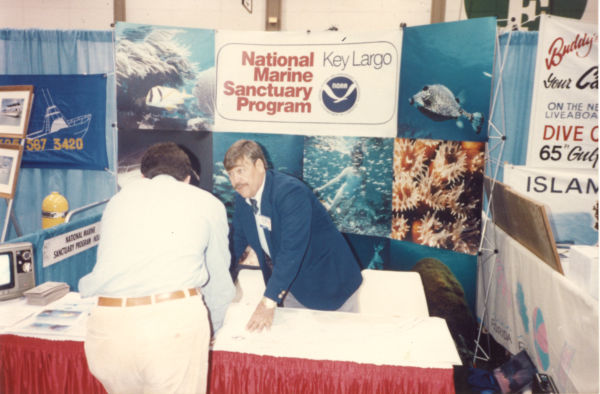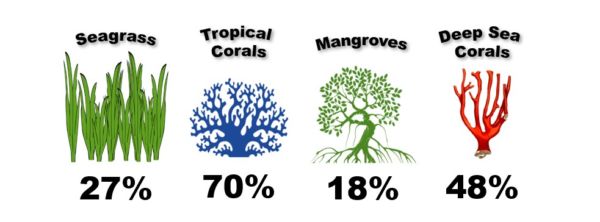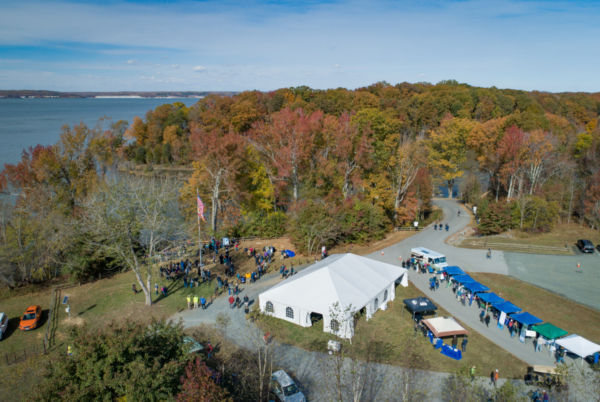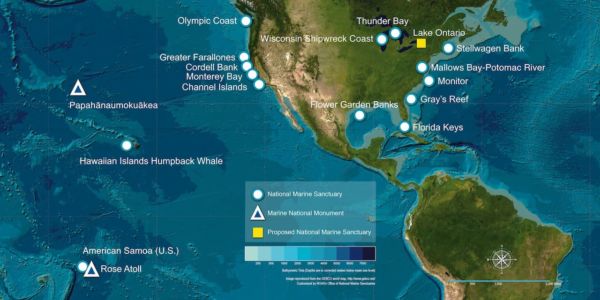Fifty years ago, a new era of ocean conservation was born when the United States created a system of national marine sanctuaries. Since then, the National Marine Sanctuary System has grown into a nationwide network of 15 national marine sanctuaries and two marine national monuments that conserve more than 620,000 square miles of spectacular ocean and Great Lakes waters, an area nearly the size of Alaska. NOAA celebrated the 50th anniversary of your National Marine Sanctuary System, making this a perfect time to reflect on the accomplishments that have made NOAA’s Office of National Marine Sanctuaries a global leader in ocean conservation and maritime heritage preservation, while looking toward the future with great optimism.
The National Park Idea
In March of 1872, President Ulysses S. Grant established Yellowstone National Park, and Americans were introduced to the idea of setting aside special places for the enjoyment and pleasure of the people—sparking a worldwide movement. The creation of modern parks became a powerful tool for the conservation and protection of valuable places. As more and more terrestrial places were set aside for protection, so too were national seashores and wild and scenic rivers. Eventually came the realization that protection doesn’t have to end at the shoreline. Flash forward to 1972, when President Richard Nixon signed the Marine Protection, Research, and Sanctuaries Act, and three years later, the underwater resting place of the shipwrecked Civil War ironclad USS Monitor became the first national marine sanctuary in the United States.
Growth and Global Leadership

From 1975 to 2000, 13 national marine sanctuaries were designated within the U.S., with the 1990s being the most active decade for new sanctuary designations. Stellwagen Bank, Flower Garden Banks, Monterey Bay, and Hawaiian Islands Humpback Whale national marine sanctuaries were all established in 1992, followed by Olympic Coast in 1994. It wasn’t until the reauthorization of the National Marine Sanctuaries Act (NMSA) in 2000 that the disparate collection of underwater parks of all different sizes, shapes, and purposes scattered across the U.S. formally became known as a system—the National Marine Sanctuary System—as we refer to it today.
In 2001, the program that managed these places, the National Marine Sanctuary Program, was elevated from a division to an independent office within NOAA, with its own budget and resources. This is how the agency became known as NOAA’s Office of National Marine Sanctuaries. This restructuring opened the door to building increased operational capacity and infrastructure, the creation of new education, outreach, and science programs, and a more formal approach to managing the system for better results.
Each national marine sanctuary and marine national monument within the system has a unique history and purpose. These special places all across the United States were put in place to protect important natural, cultural, and historic resources, while also allowing compatible uses in responsible ways that have a low impact on the environment. “Over the years, NOAA has mapped, surveyed, monitored, and evaluated changes in the health of resources within these underwater parks, and used this information to make smarter management decisions,” said John Armor, director of NOAA’s Office of National Marine Sanctuaries. “This approach has made us a global leader in the conservation of natural and cultural underwater resources.”
This global leadership role was first demonstrated in 1986, when the sanctuary program hosted the first international meeting of marine protected area managers in the sanctuaries in Florida and California.
International collaboration was further strengthened when, in 2013, the National Marine Protected Area (MPA) Center was integrated into NOAA’s Office of National Marine Sanctuaries, connecting the system of sanctuaries with the larger network of MPAs throughout the nation. The MPA Center leads international partnerships, working with marine managers around the world to protect shared resources and address common challenges, such as the whales of Stellwagen Bank National Marine Sanctuary that migrate to the warm waters of the Caribbean to calve and raise their young.
Science and Maritime Heritage

From lush seagrass beds to slow-growing, deep-sea corals, the habitats protected by sanctuary waters vary greatly from place to place. Due to threats such as climate change, pollution, and increasing population growth in coastal areas, effective management is necessary to keep these fragile ecosystems protected for future generations. Since sanctuaries serve as sentinel sites where the impacts of ocean acidification and climate change can be studied over time, sanctuary researchers have also been monitoring ocean conditions and assessing the impacts of a changing climate on ecosystems and coastal communities.
Many sites serve as a proving ground for new approaches to restoring and managing marine ecosystems in the face of climate change and other threats. Mission Iconic Reefs, a massive collaborative effort to restore almost three million square feet of reef at seven iconic sites within Florida Keys National Marine Sanctuary to a sustainable state is currently underway, and in California, Greater Farallones National Marine Sanctuary and the Greater Farallones Association are implementing strategies for kelp forest restoration, monitoring, research, and public engagement.
National marine sanctuaries are also great places to research and test approaches for mitigating human impacts on wildlife. Since 2007, NOAA has worked to better understand how ship strikes impact endangered whale populations in national marine sanctuaries on the West Coast. This information was used to create the Blue Whales and Blue Skies initiative, where they worked with major shipping companies who voluntarily reduced their vessel speeds in key areas to 10 knots or less. The 2020 vessel speed reduction program resulted in cutting over 700 tons of smog-forming emissions, and a 35% decrease in ship strike risk.
With some major advancements in technology, such as remotely operated vehicles (ROVs) and benthic mapping, our ability to explore deep-sea habitats and make new discoveries in deep-ocean science has increased dramatically. Vailulu‘u Seamount in National Marine Sanctuary of American Samoa, was discovered in 1975, but it wasn’t until 1999 that researchers were actually able to map this seafloor feature using remote sonar methods, and found it to reach 16,000 feet deep and summit at about 2,000 feet deep.
In 2005, NOAA Ocean Exploration conducted ROV dives there and found there was a very dynamic and robust hydrothermal system, providing habitat to an array of deep-sea organisms. In 2012, the sanctuary expanded to include Vailulu’u Seamount (and other important sites). Since then, more expeditions were made to the seamount using ROVs to explore geologic features and marine biodiversity, including an expedition on Ocean Exploration Trust’s E/V Nautilus in July 2019 when a new hydrothermal vent was discovered, signifying that Vailulu’u is still active.
In addition to protecting natural resources, national marine sanctuaries also protect cultural resources such as shipwrecks and heritage artifacts and locations. Currently there are 1,211 known shipwrecks protected throughout the sanctuary system, with thousands still waiting to be discovered in these waters. The program focuses on several key research areas, such as maritime history, site inventory and assessment, and maritime cultural landscapes.
Putting Sanctuaries on the Map
National marine sanctuaries and monuments are often thought of as the national parks of the ocean. One major difference, however, is these places do not have roadways that lead to entrance gates with a ticket booth like most national parks do. So how do we inspire people across America to get into their sanctuaries? How do we make sure people know that the waters they enjoy boating, fishing, surfing, diving, and wildlife viewing in are part of a protected national treasure? We do this through strategic communications, education and outreach programs, and by working with hundreds of public and private partners on the federal, state, regional, and local levels.
Thanks to the goals laid out in the 2000 reauthorization of the NMSA, there was a major shift in focus towards enhancing public awareness. This was the catalyst that led to some of our most successful education and outreach programs today, such as the Ocean Guardian School program, LiMPETS, the Bay Watershed Education and Training program (B-WET), and the Sanctuaries Webinar Series. Additionally, over 44 million people attend our visitor centers and those of our partners in the zoo and museum community annually.
A Model For Public Involvement

Your National Marine Sanctuary System serves as a model for community involvement in the protection and management of public resources. The 1992 reauthorization of the Marine Protection, Research, and Sanctuaries Act was a significant overhaul of the act, which included giving the program independent authority to establish a Sanctuary Advisory Council at each site within the system.
Sanctuary Advisory Council members represent a broad cross-section of the communities adjacent to national marine sanctuaries, and Papahānaumokuākea Marine National Monument, and represent local interests such as conservation, education, research, fishing, wildlife watching, diving and other recreational activities, boating and shipping, tourism, harbors and ports, maritime business, agriculture, maritime heritage, and Indigenous cultures.
The people who live and work in the communities surrounding national marine sanctuaries care deeply about these places. Sanctuaries have always been tightly woven to the local communities around them, but perhaps the most significant change to the system came in 2014, when the new Sanctuary Nomination Process was implemented, leading to a community-driven process for deciding which special underwater places should be considered for sanctuary designation.
Shortly after, nominations for new sanctuaries came from members of communities from all across the country. Nominations that successfully complete the process are added to an inventory of areas NOAA could consider for designation, which then undergo an extensive scoping, proposal, public review, and designation process. It was through this new process that Mallows Bay-Potomac River National Marine Sanctuary officially became designated in 2016, followed by Wisconsin Shipwreck Coast National Marine Sanctuary in 2021.

The National Marine Sanctuary System will surely continue to grow. As communities around the country recommend new areas for protection, we are responding. Currently, there are four nominated sanctuaries in the inventory being considered by NOAA for designation, including Alaĝum Kanuux̂ (Heart of the Ocean) in Alaska. The proposed Lake Ontario National Marine Sanctuary and proposed Chumash Heritage National Marine Sanctuary are both in the process of designation, after having received public input on draft documents. In addition to adding new sanctuaries to the system, several sanctuaries have seen boundary expansions over the years, such as Thunder Bay, Cordell Bank, and Greater Farallones national marine sanctuaries in 2015, and Flower Garden Banks National Marine Sanctuary in January 2021. Monitor National Marine Sanctuary was also proposed for expansion in 2016 to protect the final resting place for nearly 1,700 men lost in World War II during the Battle of The Atlantic.
The 2021 National Academy of Public Administration (NAPA) review concluded that despite the small staff size and modest budget of the National Marine Sanctuary System, it has fulfilled its promise by successfully advancing its mission and vision; has developed a trusted reputation with the marine community; and has achieved positive outcomes for its communities. Keeping our core values in mind as we look toward the future, we fully embrace our responsibility to save these spectacular places and ensure the National Marine Sanctuary System remains a source of pride and enjoyment for people across the nation.
Learn more about the history of your National Marine Sanctuary System.











